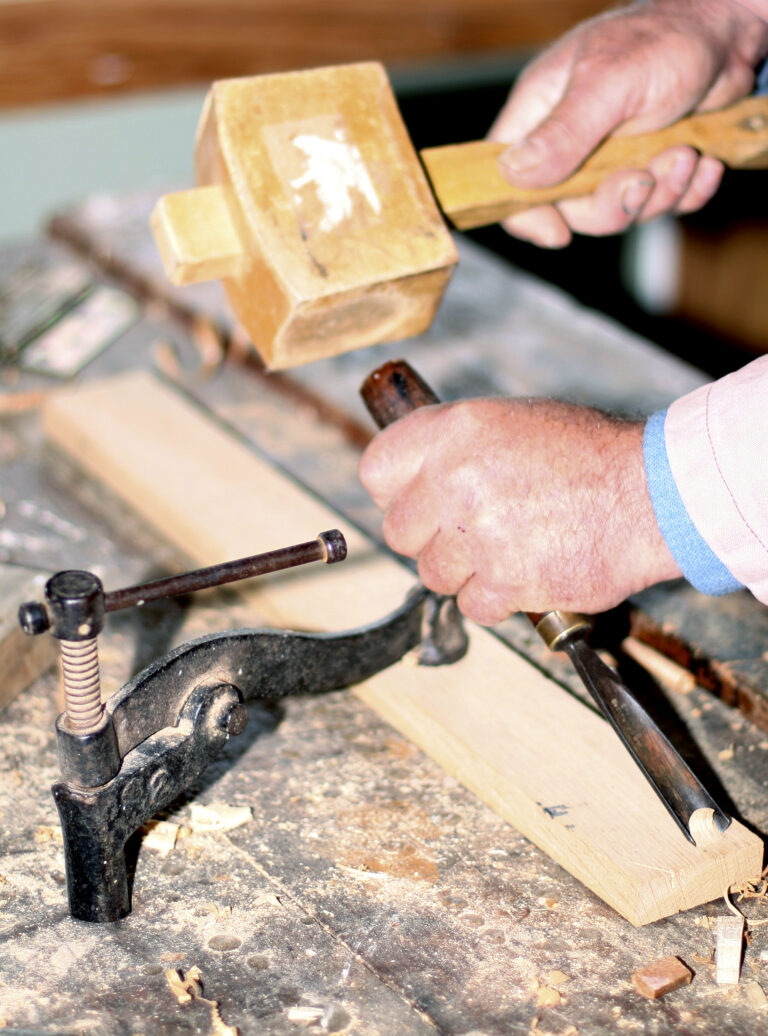Two refined lathe stop attachments take the guesswork out of turning
By Bryce Clifford
Dial gauge pushes through sleeve in clamped block.
Those of us with lathes no doubt have had the experience of sending a lot of nearly completed work into the scrap bin after shaving off that last few hundreds of a millimetre too much. Frustrating to say the least, and doesn’t make for a happy camper in the workshop. Over the holiday break, I decided that my little Boxford lathe needed a couple of refined attachments which hopefully would take a lot of the guesswork out of the turning process. One is a basic steel stop-bar and the other a sort of a poor man’s digital-readout lathe attachment using a dial gauge. These are accurate stops to prevent the saddle going past a defined point on the lathe bed.
Frustrated
I think most turners get frustrated with constantly having to stop the lathe and measure and re-measure the length along the bed as the work gets reduced. With another dial gauge set up on the cross-slide, I can also measure diameter and tool travel across the bed but it is not the subject of this article.
It’s usual that most metal lathes have graduated dials on the feed screws but accuracy here can be a problem due to varying degrees of backlash, often caused through old age and general wear. The idea of dial gauges or a steel stop-bar is not new and I claim no rights to it whatsoever, but this is still a very useful project to undertake and your turning will definitely improve.
The reason I used a dial gauge in this project is that, as the price of electronic measuring tools plummets, so it seems do the prices of dial gauges. I’ve had one of these little treasures in my toolkit for some years and it has been an invaluable tool for all sorts of purposes. They used to be horrendous prices but very serviceable economy models from machinery suppliers can now cost between $45 to $65 and this makes them almost a necessity.
No dimensions are given here as it depends upon the profile of your lathe bed and just what scrap you have in your bin to make it.
Partly assembled stop. Note screw in hole for gripping stop or dial gauge.
Two stops
From a previous project, I had two nuggety aluminium offcuts about 75mm long by 50mm wide by 13mm thick, so I decided to make two stops. One is a dedicated stop so that the saddle can be stopped at a defined point each time, such as when cutting up to a shoulder or step. The second stop was made to hold the stem of my dial indicator so that I could accurately traverse the saddle and cutting tool an exact distance along the bed.
The stops are made of two basic parts – a top section and a lower clamped section which locks up to the underside of the lathe bed when snugged down with a sock-et screw or suitable bolt. I have a small ledge cast into my lathe bed so that when I turn the socket or cap screw it clamps both parts of the block up tight.
Basic parts.
Measure
The first task in making the stop block is to accurately measure up the profile of your lathe bed and draw up a cross-section of the block. Trace this profile onto your stop material prior to cutting out the surplus to waste. I had to cut the top part of the block to allow for the diamond-shaped vee bed which runs like a rail along the lathe bed to keep the saddle and tailstock in alignment with the headstock and chuck.
I used aluminium but steel would also be quite suitable. I scribed the lines with a scriber onto my aluminium scrap and cut the surplus away with a hacksaw. Final fitting to ensure a tight, neat fit was done on the milling machine. Careful filing will do the job just as well but you must take it slowly, file care-fully and check the fit on the lathe bed often.
Bryce using home-made dial gauge stop.
Clamping
When you’re happy that the top block sits neatly and square with the lathe bed, you can then consider the bottom or clamping part of the stop. For this, I used a solid section of steel bar cut to a suit-able length and dressed up all nice and square. While, like mine, your piece of steel could come from the scrap box, it also needs to be quite robust as you don’t want it bending or deforming under load when clamped up.
For the clamp screw, a socket or cap screw is ideal but a simple bolt would do just as well. The idea here is to clamp the two sections together and drill them as an assembly. Remember that the lower clamp section will need to have a thread tapped into it, so drilling with a pilot hole first is the answer. You can then tap the thread in the lower clamp block and enlarge the upper block to accommodate the socket screw or bolt as needed.
Lathe stop fixed on.
Tap
I used a 6 mm socket screw as I had a tap that size. I also installed a short 4 mm diameter pin in the underside of the top unit so that the lower clamp block retains its position when the clamping screw is released. I simply pushed the pin into the top block with Loctite which seems to work very well. You need to drill a cross-hole horizontally through the unit to install the small, 100 mm-long piece of 8 mm diameter round bar which can lock in any position with the brass machine screw. The top and bottom blocks are slid anywhere along the bed and locked up with the clamp screw, then the 8 mm bar can be moved to its final position and locked up snugly with the brass screw.
The brass screw hole also requires tapping with a suitable thread.
Assembly.
Accurate
You can make your cuts along the job using the apron hand-wheel by bringing the saddle to the bar. Naturally enough, the lathe carriage will stop when it hits the obstruction. Here’s where an accurate profile of the block is important as, once locked up, it needs to be very solid and must not be allowed to move on the bed.
When you are machining up to the stop, it’s nice to feel that reassuring bump as the saddle stops at your designated stop point. You know the cutting tool point is stopped where it should be, neither a fraction of a millimetre fore or aft of its required position.
The other advantage of the stop block is that, with the stop-bar hole 8 mm in diameter, it is a very easy task to install the dial gauge and lightly snug up with the brass lock-screw. It appears that 8 mm is the standard industry size for dial gauge stems and therefore just about any dial gauge should fit.
The horizontal hole across the block needs to be accurately drilled and must be square to the vertical surface of the block and parallel to the longitudinal length of the bed. If possible, it should be reamed to ensure a nice snug fit so that the dial gauge can be gently clamped in using the brass screw
(Seen from below) Top and bottom sections clamped on.
Dial gauge
I have a long-travel dial gauge that will travel 30 mm. Again, it is easy to lock the clamp block in a suitable position on the bed, bring the tip of the dial gauge to the saddle and zero it up. Then, as you move the lathe saddle towards the headstock, you can see the comforting swing of the dial as it shows every fraction of a millimetre moved while the saddle traverses horizontally along the bed towards the chuck. As long as you’re careful, your errors should be things of the past and you can do away with all that tedious measuring and stopping and starting.
Had I had a little more time and material to play with, I would have omitted the brass screw to lock the dial gauge in place and arranged for the clamp bolt to lock both the lower clamp section and the 8 mm bar or dial gauge stem, by simply slitting the block in an appropriate location with a slitting saw.
Bryce tapping thread in.
Deluxe
In fact, I intend to buy some additional material and will construct a deluxe version shortly with both locking bar and dial gauge incorporated into the one unit. The unit here, however, has been a prototype design and has been a very useful addition to my lathe kit.
I encourage you all to have a go at making this attachment. I think you will be surprised at the extra benefits you will receive in the quality of the work you will turn out. I also realise that there are a lot of very talented toolmakers and machinists out there that will have better and smarter means of achieving the same result. However, we all have to start some-where and going back to basics is a great way for others not so skilled to learn.



